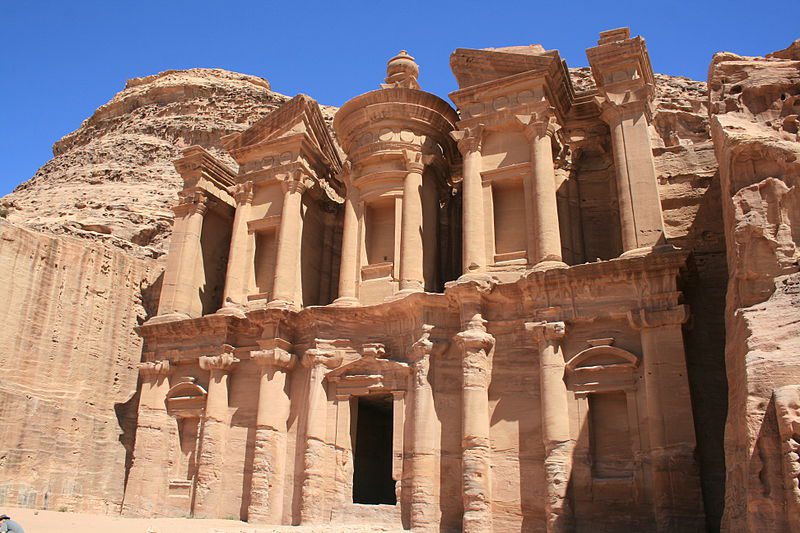The exact location of this site is extremely important, for it forms part of the southern boundary of the Land of Israel,1 and it is in this place that the Jewish people spent about half the time that they were in the wilderness.2 There is a debate amongst the commentators as to whether Kadesh Barnea refers to one place or two. Rashi and the Ramban mention that there were two places known as Kadesh,3 one located within the Land of Israel and the other located outside the border, in the wilderness. Whereas Rav Avraham Ibn Ezra and the Seforno are of the opinion that Kadesh Barnea was one place located on the border between The Desert of Tzin and The Desert of Paran.4This author follows the opinion of Rashi and the Ramban that there were two places called Kadesh. I suggest this based on archeological evidence and ancient sources that the Kadesh of Paran was located in the vicinity of the ancient city of Petra; and that the Kadesh mentioned in conjunction with the land of Israel was located at the site of Khirbet Khanazir, which is about seven miles south east of the Dead Sea in modern day Jordan. This conforms well to the south eastern border of the land of Israel laid out in the books of Numbers and Joshua.
The Torah mentions the place as both Kadesh and Kadesh Barnea. We find that one was located in the wilderness of Paran, and the other being located in the wilderness of Tzin. The wilderness of Paran is outside of the land of Israel while the wilderness of Tzin is located on Israel’s southern border.
Kadesh Barnea of Paran
The identification for this location seems pretty solid based on the following evidence. The Hebrew name Kadesh Barnea is translated consistently by Targum Onkelos as: Kadesh as Rekam, andBarnea as Gaiya. The ancient Jewish historian Josephus associates Rekam with the city of Petra.5The name Rekam also appears in the Dead Sea Scrolls, in a description of a prominent Edomite site most closely resembling Petra and associated with Mount Seir.6 There was also an inscription found on a rock wall of Wadi Musa in Petra, opposite the entrance to the narrow canyon called the Siq, which includes the name Rekam.7 Early Christian sources also claim that Petra and Rekam are the same place.8
Josephus mentions that Aaron’s burial site is in the mountains surrounding the region of Petra.9 This tradition has been upheld throughout the ages. To this day it is possible to visit Jebel Haron (“The Mountain of Aaron” – the Arabic name for the site). This Arabic identification of the site correlates with the biblical evidence of the location of Aaron’s burial site, for the Torah states that the nation traveled from Kadesh to Hor Hahar – the biblical name for the mountain where Aaron was buried, without any stops between them.10 Moreover, Rashi11 states that the mountain was called Hor Hahar (lit., “the mountain of the mountain”) because it had the appearance of one mountain that stood atop another mountain. The site that has been traditionally accepted as Aaron’s burial site lies on a mountain that fits this description.
Was Kadesh Barnea of Paran settled during Israel’s stay in the wilderness?
There is no biblical reference to Kadesh Barnea in the desert of Paran as a city, nor have any archeological findings identified a city from biblical times that could have been Kadesh. According to secular scholarship, the site was inhabited during the Neolithic age, and then abandoned until the time of the Edomites, in about 1200 B.C.E.
Kadesh of Tzin
Finding Kadesh in the wilderness of Tzin is a little trickier. Since 1905 most secular scholars have claimed that the site of Ain el-Qudeirat in the Wadi el-Ain of the northern Sinai is the location of the biblical Kadesh Barnea. Several Iron Age fortresses have been excavated there. The oldest, a small, oval structure, has been dated to the tenth century B.C.E. A second fort, constructed during the eighth century B.C.E., was destroyed a century later.
This suggested location seems to clash with the biblical evidence. We know that the Kadesh both in the wilderness of Paran and Tzin mentioned in the Torah were close to the land of Edom.12Traditionally, Edom has been located in the highlands of Jordan, east of the Arava Valley. Rashi andTosafot on the opening Mishnah in tractate Gittin refer to Rekam as being on the southeastern side of the Land of Israel.13 Regarding the borders of the land of Israel the Rambam uses this Mishnah in defining the borders, and mentions that Rekam is on the South Eastern corner of the land of Israel.14 15
Whenever Kadesh Barnea is mentioned in conjunction with the border of Israel it is always in the vicinity of Tzin. Rav Moshe Alshich and the Seforno mention in their commentaries that Kadesh in Tzin was a city.16 Finding any city dating from the time of the exodus in the Late Bronze Age is a tall order; yet there is one such place in the vicinity of Tzin that was inhabited then and has ample water: Khirbet Khanazir.
Tosafot17 quotes the verse in Genesis 20:1 that speaks about Avraham journeying to the south and settling between Kadesh and Shur in the city of Gerar. He is bothered by the fact that the land of the Philistines where Gerar is located, is in the west of Israel while the Mishnah seems to imply thatRekam is in the east. He goes on to try to understand where these places were located. I would like to suggest a different possibility. In the story of Hagar’s expulsion we find her on the way to Shur. Shur in Hebrew can mean wall. We know that Hagar was an Egyptian. It is also known that Pharaoh Amenemhat I (1991 B.C.E. to 1962 B.C.E. 61 years before Avraham came to the land of Israel) built a wall to defend the eastern border of Egypt.18
It might be that the word Shur is referring to this Egyptian border fence and Kadesh referring to Khirbet Khanazir (which according to the limited research I can find on the place was also inhabited at that time). If that is the case than we solved the problem of Tosafot, for Gerar is between Khirbet Khanazir and the Egyptian border.
Based on the above we have solid evidence for Kadesh Barnea in the wilderness of Paran being located in the vicinity of Petra, and a solid theory as to the identity of Kadesh in the wilderness of Tzin. Furthermore textual evidence would seem to point to both sites of Kadesh being located on the southeastern border of the Land of Israel, as mentioned in the book of Numbers and in the book ofJoshua19.
________________________________________
1 Numbers 34:4; Joshua 15:3
2 Deuteronomy 1:46; Rashi ad loc states that 19 of the Israelites’ 38 years of wandering were spent at Kadesh.
3 Rashi Numbers 32:8; Ramban ibid 12:16, 20:1
4 Ibid 20:1
5 Josephus, Antiquities of the Jews Book IV, 7:1
6 Scroll 4Q462
7 Iain Browning, Petra (Chatto & Windus, 1974), p. 108; on p. 109 there is a drawing of the inscription.
8 Eusebius and Jerome (Onom. sacr. 286, 71; 145, 9; 228, 55; 287, 94)
9 Josephus, Antiquities of the Jews book IV, 5:7
10 Numbers 20:22
11 Ibid.
12 Numbers 20:16
13 Talmud, tractate Gittin 2a
14 Mishnah Torah; Hilchot Terumah 1:7
15 It is most likely that the Rekam referred to in this Mishnah is the Rekam of Paran.
16 Numbers 20:1-2
17 Alshich Ibid; Seforno ibid 12:16
18 Ian Shaw, The Oxford History of Ancient Egypt, Oxford University Press 2000 pp. 159, M. Lichtheim, Ancient Egyptian Literature, volume 1, University of California Press 1973 p.224, Aidan Dodson, Monarchs of the Nile, American Univ in Cairo Press 2000 p. 57
19 Numbers 34:4; Joshua 15:3

